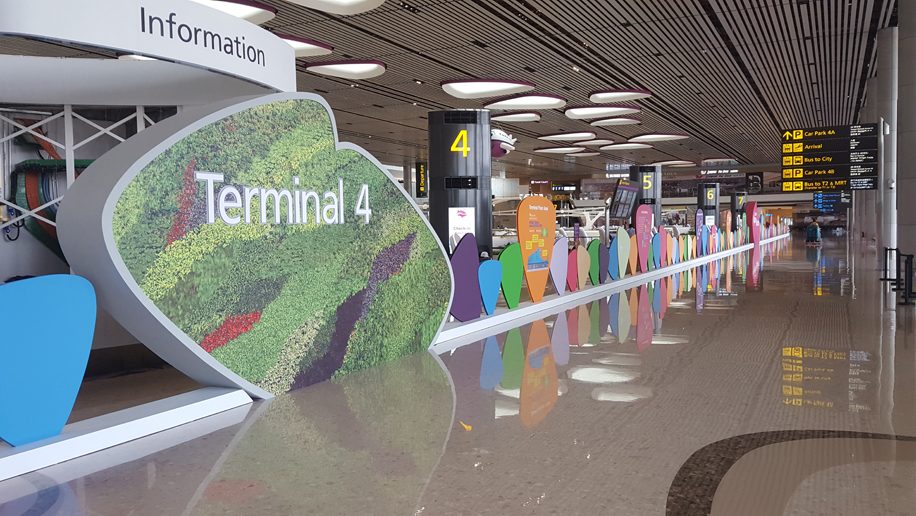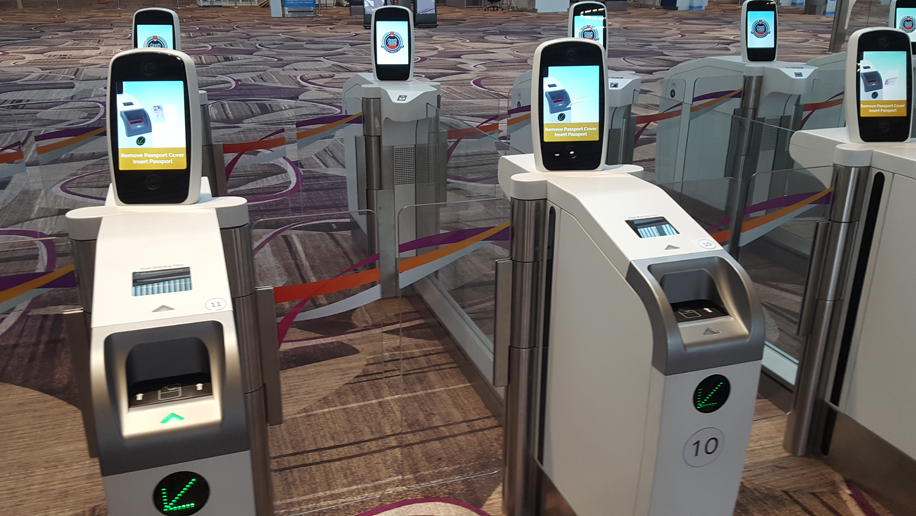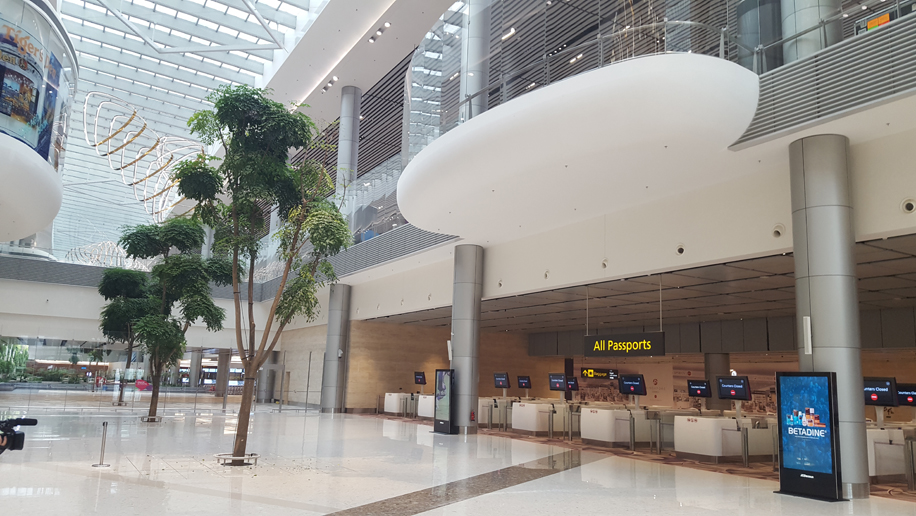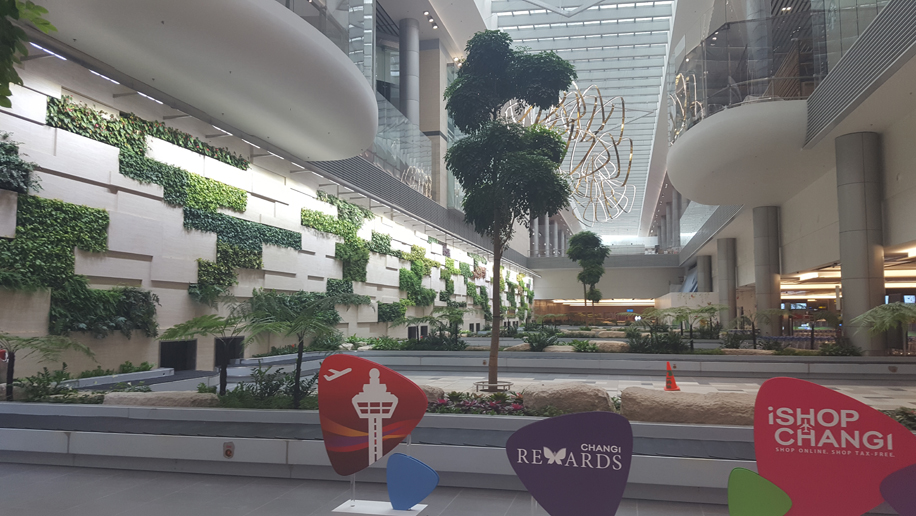
Key information
Changi Airport’s upcoming Terminal 4 building has now been fully unveiled. The new terminal is located on the site of Changi’s former budget terminal at the southern end of the airport.
Covering two floors and occupying a floor space of 225,000sqm, Terminal 4 is the smallest of Changi’s terminal buildings (about half the size of Terminal 3), but also its most advanced. Building for the terminal began in 2014, with operations expected to begin by the end of this year (final testing is still currently underway, and a specific opening date is still to be set).
When it becomes operational, T4 will add some 16 million (two-thirds of what the twice-larger Terminal 3 can serve) to the airport’s passenger handling capacity, which currently stands at a total of 66 million per annum. When it begins operations at the end of this year, however, only about half of this capacity is initially expected to be used. So far, only nine airlines are due to re-locate to the new terminal, though this is expected to grow as time goes on – Changi deliberately made this decision so as to not over-exceed its capabilities during the initial teething process.
Oneworld’s presence at Terminal 4 will be solely represented by Cathay Pacific (while this does make oneworld transfers a little difficult, Cathay’s flights to Singapore tend to terminate there rather than flying via the Lion City to other destinations).
Meanwhile Skyteam will have two airlines – Korean Air and Vietnam Airlines – based at Terminal 4. No Star Alliance carriers are currently set to operate out of the new terminal, presumably to ensure better connectivity with member carrier Singapore Airlines.
Also relocating to the new terminal are Air Asia Group’s four individual airlines, as well as Philippine budget airline Cebu Pacific, and Chinese low-cost carrier Spring Airlines.

Departures Hall
What’s it like?
Changi Airport’s two major criteria for the terminal, that it be its first end-to-end fully automated terminal and that it offer a more “boutique” airport experience, are both delivered in spades. The terminal offers Changi’s first end-to-end fully automated departure process – what it calls Fast and Seamless Travel (FAST) – which includes self check-in, baggage drop and immigration. Meanwhile the design of the terminal is by far the most “fun” of the entire airport’s facilities. Bright colours, fun and modern seat designs, kinetic “petal” sculptures, massive LED displays, and – in line with its upcoming arboreal-focused Jewel development – more trees within the terminal than Terminals 1, 2 and 3 combined (a total of 186 large trees).

Check-in
Terminal 4 has been set up to offer centralised departure and arrival areas. Check-in counters are orientated at an angle towards the immigration and security screening areas, making movement around the terminal much more intuitive. A large glass divide separates the check-in and airline-side departure areas but keep the overall space feeling large and open despite the terminal’s comparatively smaller size.
The end-to-end automated departure system starts here with self check-in stations, which have been developed by Changi Airport and will be the same across all airlines rather than machines being unique to each carrier. For travellers familiar with the machines used by budget airline Jetstar at Changi’s Terminal 1, these machines are the same ones.

Self check-in is intuitive and efficient – the process takes little longer than two to three minutes – and instructions are clearly laid out. Biometric screening is used to check-in passengers – a camera takes a photo of the traveller’s face and matches it against their passport photo. Note that the machine measures key facial features and structure rather than details such as haircuts and facial hair, so barring reconstructive surgery passengers can rest assured that the scanning will work even if they look slightly different to their passport photo. The scanning works by filming a short video and selecting the optimal “frame” that best meets the necessary criteria, making absolute stillness while the photo is being taken not necessary. Glasses do need to be removed during this process, however.
Passengers receive their baggage tag (which they have to apply themselves when doing self bag drop) before their boarding pass, ensuring these aren’t accidentally missed by passengers.
Take a look at the video below to see a demonstration of the self check-in.
Changi Airport predicts about 30 to 40 per cent of travellers will use the self check-in stations initially. Not all of the airlines that are relocating to Terminal 4 have this capability, however, and there are manned check-in desks as well. Of particular note here is that the scales and conveyor belt that luggage is placed on its much more low to the ground than in most airports, making it easier for passengers to lift heavy luggage, or for those with difficulties lifting baggage. These manned desks can be removed in future and replaced with self check-in stations as the need increases.
Baggage-drop
Passengers that do self check-in then move on to a separate kiosk for baggage drop. These are unmanned, though do have a slide-out desk for staff to man should an individual need arise. Cameras within the baggage placement area measure the luggage to ensure it meets requirements and that there are no extended handles or other protrusions that could cause the luggage to create a blockage. An alert goes out to staff if assistance is needed.
Elite travellers and frequent-flyer members that may be concerned this automated process may mean stricter limitations on luggage, fear not. The machines allow for specific tolerances that each airline is able to individually programme into the machines. Additional leeway can be programmed for FFP members or those travelling in particular cabin classes.
Travellers get their luggage tags when checking in, and these need to be applied by passengers themselves. A straightforward two-step process is illustrated clearly on the baggage tag itself regarding how luggage should be tagged.
Take a look at the video below to see a demonstration of the baggage drop.
Immigration
Much like the check-in and bag drop systems, immigration is fully automated using biometrics that were taken upon arrival. Singapore citizens and permanent residents can automatically use the systems, and travellers of other nationalities can register beforehand in order to use the service (see a full list of requirements and eligibility at the Immigration and Checkpoints Authority website). Travellers scan their documents, provide their thumbprint and facial recognition scan, and are able to proceed.
Also as with check-in, manned stations are available as well for those going through regular immigration clearing.
At this stage, Changi Airport has had no requests from any airlines or airline alliances for dedicated channels at Terminal 4.

Security scanning
Easily the most impressive part of the security screening area of Terminal 4 is the massive, 70-metre-long LED screen that stands above the zone. Designed to offer a distraction from what is otherwise the “very stressful” process of security clearance, the screen showcases truly mesmerising animations featuring Singapore landmarks, key destinations around the region, as well as a fun animated video depicting little creatures manning an elaborate steampunk-esque baggage handling system.

Security screening itself has received a notable upgrade. Each queue (barring the furthest to the right) has both a metal detector and full-body scanner, the latter not requiring removal of any clothing such as shoes or belts. Meanwhile hand luggage is scanned using a CT scanner rather than a traditional x-ray, enabling staff to get a three-dimensional image of the bags.
For business travellers, the new scanning has two massive benefits. Firstly, the three-dimensional CT scanning means that items such as laptops or other devices don’t need to be removed prior to scanning – just empty your pockets, place down your bag, and you’re on your way. Secondly, the conveyor belt has been designed with two access points side-by-side, and Changi Airport itself actively encourages travellers to “jump the queue” ahead of others who are taking a fair amount of time in order to speed up the process.

Retail
Past the security screening are is a winding path through the duty free zone, operated by The Shilla Duty Free. Things to keep an eye out for – craft beer and whisky bars offering the chance to sample what’s on offer.
Beyond this is a waiting area with seats and shops (Coach, Michael Kors and Gassan Watches are among the more notable brands present) and temporary installations from each of the six airlines operating at the terminal. These include a Cathay Pacific business class seat product on display that can be tried out.
At the end of this area is another seating area set against a backdrop of Singapore brands with traditional Peranakan-style shophouse storefronts. Keep an eye out for the central storefront, which is actually a disguised LED screen showcasing a series of videos featuring traditional life in Peranakan-style houses and beautifully animated sequences with musical accompaniment.
Lounges
There are two key lounges at Terminal 4 in the transit area on the second floor above the main waiting and shopping area. The first of these is a Cathay Pacific First and Business Class Lounge – one of the airline’s largest outside of Hong Kong – while the second is a collaborative lounge from SATS and Plaza Premium, the Blossom Lounge.

Boarding gates
The majority of Terminal 4’s trees are located along the boarding gates, creating a sort of French boulevard aesthetic. Mist is also sprayed out from the tops of the trees at regular intervals, providing something of a tropical rainforest vibe.
Boarding gates also use biometric screening and are fully automated. Passports are unnecessary at this stage, as the machines again use facial recognition against the previous photos taken at immigration. All boarding is done using aero bridges, which can service all aircraft types.
While there are a variety of seats at each of the gates, there aren’t that many of them meaning waiting at the gate is unlikely to be a convenient option. Changi Airport says the fact it’s only starting operations at half capacity shouldn’t mean an issue with seating at the gates, though as capacity increases this could become a problem.

Facilities
Toilets in the new terminal have a distinct, traditional Singaporean aesthetic, with textured tiling, warm lighting and decorative ceramics – definitely worth taking a look at.
Meanwhile, travellers can be on the lookout for the automated cleaning bots that patrol the terminal. While human cleaners also operate in tandem with the bots to clean the harder to reach areas, the large robots take care of the larger open areas.

Arrival Hall
What’s it like?
Arriving through Terminal 4 appears as though it will be quite a pleasant experience all things said, notably due to the large open spaces available. In the heart of these are incredibly high ceilings with hanging kinetic petal-like installations. Trees are located down the centre of the arrivals area, once again adding a refreshingly green atmosphere to the airport experience.
Transiting
This is one of the areas that Terminal 4 is perhaps not so strong on, which is arguably why a number of the airlines now based there typically terminate at rather than transit through Singapore. Passengers are required to head down to a separate transit waiting area, where shuttle buses take passengers to Terminal 2. Buses come every 10 minutes and take about five minutes to get to the terminal. Passengers transiting to flights departing from Terminals 1 and 3 will then have to get the usual Skytrain from Terminal 2 (note that the trains for Terminals 1 and 3 are at either ends of Terminal 2).

Immigration
As with the Departures Hall, the Arrivals Hall has automated immigration kiosks that use biometric screening, along with manned options. Again, the automated booths are available for Singaporean citizens, permanent residents and registered travellers.
Baggage claim
The most notable feature of the baggage claim area is undeniably the green wall that sits below a high section of the ceiling with natural light pouring in and yet more kinetic art installations hanging from the ceiling. Large, white brickwork is interspersed with foliage coming out of the wall, while other plants and trees dot the zone itself.

Transportation
Buses to the MRT underground trains can be accessed by bus from the terminal (the same as transiting to Terminal 2). Other buses to the city are also available to the right when exiting the terminal, as is a coach area. To the left is the car and taxi pick up, as well as the car park.












